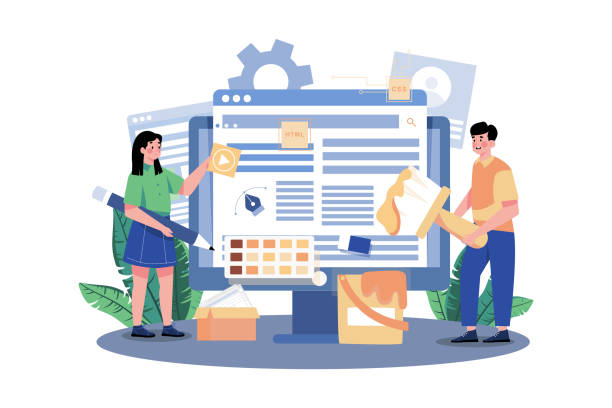1. Introduction to Responsive Website Design and its Importance in the Digital Age

In today’s world, where users access the internet from various devices, #Responsive_Website_Design or Responsive Web Design is no longer a luxury option, but a vital necessity.
This design approach ensures that your website is displayed in the best possible way, regardless of the user’s device screen size, from desktops to tablets and smartphones, providing an optimal user experience.
The importance of responsive website design goes beyond aesthetics; it directly impacts your SEO, conversion rates, and customer satisfaction.
A non-responsive website can easily lose mobile users because navigating and reading content on it will be difficult, which in turn leads to an increase in bounce rate and decreased engagement.
From an educational perspective, understanding this concept forms the foundation of any modern web development project.
In fact, Google has explicitly stated that website responsiveness is an important factor in search ranking results, especially with the Mobile-First Indexing approach.
This means that if your site is not optimized for mobile, it may be less visible in search results.
Therefore, adopting the responsive design approach not only improves the user experience but also significantly contributes to your business’s success in the digital space.
The main goal of this type of design is to provide accessible and usable content for everyone, without the need to develop separate versions for each device.
This explanatory and comprehensive approach helps developers and business owners gain a better understanding of the challenges and opportunities ahead.
Did you know that your company’s website is the first point of contact for 75% of potential customers?
Your website is the face of your brand. With **Rasaweb**’s corporate website design services, create an online presence that builds customer trust.
✅ Create a professional and lasting image for your brand
✅ Attract target customers and increase online credibility
⚡ Get a free consultation from **Rasaweb** experts!
2. The Difference Between Responsive Design and Adaptive Design

In the world of #Web_Design, the concepts of #Responsive_Design and #Adaptive_Design are often used interchangeably, but these two approaches, despite their similarities, have key differences.
Responsive website design operates on a fluid and flexible approach; meaning the website continuously adapts to the screen size using CSS Media Queries and relative units (such as percentages).
This allows the website to display well on any screen size, regardless of whether it was previously defined for that specific size.
In contrast, adaptive design works based on a set of predefined fixed layouts (breakpoints).
In other words, the designer creates separate layouts for a few specific screen sizes (e.g., 320px, 768px, 1024px), and when the page loads, the server or browser detects what device the user is using and provides the most suitable predefined layout.
From an analytical perspective, responsive design is more suitable for covering a wider range of devices due to its greater flexibility and usually requires less maintenance because there is only one codebase for all devices.
However, on the other hand, it might be slightly heavier in some cases due to loading all elements for all sizes.
Adaptive design can offer more precise control over display at each specific breakpoint and may be faster in initial loading, as only the codes related to the current layout are loaded.
But this approach requires managing and developing multiple separate layouts, which can increase complexity.
From a specialized point of view, the choice between these two depends on the specific project needs, budget, and performance priorities.
Some projects leverage a combination of these two approaches to achieve the best performance and flexibility.
Ultimately, both aim to improve the user experience across different devices but choose different paths to achieve it.
3. Technical Principles and Key Tools in Implementing Responsiveness

Implementing #Responsive_Website_Design requires a deep understanding of technical principles and appropriate tools.
The core of responsiveness rests on three main pillars: Media Queries in CSS3, Flexible Grids, and Flexible Images.
Media Queries allow developers to apply different CSS rules based on device characteristics (such as screen width, orientation, or resolution).
This means you can make fonts smaller, stack columns vertically, or change navigation elements to a hamburger menu for smaller screens.
Another key element is the viewport meta tag, which instructs the browser to set the page width based on the device width for correct scaling.
Practical Guidance: Using relative units like percentages (%) for widths and heights, and `em` or `rem` for font sizes instead of fixed pixels, is crucial for creating flexible grids and elements.
This ensures that your layout dynamically adapts to the available space.
Also, images should be managed so they do not overflow their container and scale up or down to fit the available space.
This can be easily achieved with the `max-width: 100%;` property for images in CSS.
From a specialized perspective, tools like CSS frameworks (such as Bootstrap or Foundation) and CSS preprocessors (like Sass or Less) can significantly speed up and organize the development process of responsive design.
These frameworks provide pre-built grid systems and responsive components that make the work easier.
Below is a table of some of the most important CSS properties for implementing responsive design:
| CSS Property | Description | Example Usage |
|---|---|---|
| @media (min-width: …) | Defines CSS rules for specific screen widths | `@media (min-width: 768px) { body { font-size: 16px; } }` |
| max-width: 100%; (for images) | Ensures the image does not exceed its container’s width | `img { max-width: 100%; height: auto; }` |
| flexbox / grid | Manages flexible and complex layouts | `display: flex; flex-wrap: wrap;` |
| viewport meta tag | Sets page scaling for mobile devices | `<meta name=”viewport” content=”width=device-width, initial-scale=1.0″>` |
4. User Experience (UX) in Responsive Website Design

Responsive website design is not merely about a website reacting to screen size; its main goal is to provide an optimal and seamless user experience (UX) on every device.
In this context, #Responsive_User_Experience means ensuring that interaction with the website, navigation, content reading, and desired actions all occur naturally and easily.
From an educational perspective, the first step in responsive UX design is the Mobile-First approach.
This means first designing for the smallest screen and then moving towards larger screens.
This approach helps you focus on the most important content and functionalities and avoid unnecessary clutter.
One of the main challenges in responsive UX is #Website_Navigation design.
Traditional desktop menus can take up too much space on mobile.
Common solutions include Hamburger Menus, dropdown menus, or Tabbed Navigation.
The importance of user experience here means that the user can easily find what they are looking for.
Additionally, the size and spacing of buttons and Touch Targets are crucial for mobile users.
They must be large enough and spaced appropriately to prevent accidental clicks.
Content must also be displayed optimally.
Long paragraphs may seem tedious on mobile; using shorter paragraphs, subheadings, and lists can improve readability.
It is also advised to use highly readable fonts, and font sizes should be adjusted appropriately for each device.
Finally, continuous testing of the design on various devices and gathering user feedback is essential to ensure a truly responsive and satisfactory user experience.
This aspect of responsive website design is often overlooked but is key to your website’s success in attracting and retaining users.
Does your current website inspire the trust that potential customers should have in your business? If the answer is no, it’s time to get your professional and impactful corporate website with Rasaweb.
✅ Fully custom design tailored to your brand identity
✅ Increased lead generation and business credibility in the eyes of customers⚡ Contact us for a free consultation!
5. Optimizing Images and Videos for Responsive Display

Images and videos play a vital role in attracting an audience and conveying a website’s message, but if not properly optimized, they can place a significant burden on your website’s performance, especially on mobile devices.
In a responsive website design, images and videos must be able to dynamically adapt to the user’s screen dimensions without sacrificing quality or experiencing excessively slow loading times.
From a specialized perspective, there are various techniques to achieve this goal.
For images, using the `srcset` and `sizes` attributes within the `<img>` tag is highly effective.
`srcset` allows the browser to choose between multiple versions of an image with different resolutions and sizes, loading the version most suitable for the user’s device.
This leads to bandwidth savings and increased page loading speed.
The `<picture>` tag offers even greater flexibility, allowing you to provide different types of images (such as WebP format for modern browsers and JPEG for broader compatibility) and precise control over how images are displayed based on Media Queries.
Regarding videos, embedding videos responsively is of paramount importance.
This is typically done by placing the video within a container with a specified aspect ratio and setting `max-width: 100%;` and `height: auto;` for the video itself.
Additionally, using Lazy Loading for images and videos that are not immediately visible to the user can significantly improve the initial page load speed.
This technique defers content loading until the user scrolls to it.
It is recommended to always provide modern image formats like WebP and AVIF alongside more traditional formats to ensure the best performance for users with newer browsers.
Careful optimization of images and videos is an integral part of an efficient and user-friendly responsive design.
6. The Impact of Responsive Website Design on SEO and Google Ranking

The relationship between responsive website design and search engine optimization (SEO) is extremely vital and inseparable.
Google has explicitly stated that it prefers responsive websites, and this is beneficial for #Website_SEO for several reasons.
The first and most important reason is Google’s Mobile-First Indexing approach.
This means that Google’s bots primarily use the mobile version of your website for crawling, indexing content, and ranking it.
If your website is not responsive and provides a poor mobile user experience, this can directly negatively impact your ranking in search results.
Analytically, a responsive website has only one URL for all devices, which simplifies SEO management.
There is no need to maintain two separate URLs (one for desktop and one for mobile), which can lead to duplicate content issues and complexities related to internal links.
This integration simplifies Google’s crawling process and helps it understand and index your content more efficiently.
Furthermore, responsive website design directly impacts other important SEO factors such as page loading speed and Bounce Rate.
Websites optimized for mobile typically load faster, which is an important ranking factor for Google.
A better user experience on mobile devices makes users stay on your site longer and engage more, which leads to a reduced bounce rate.
A low bounce rate and high dwell time send positive signals to Google, indicating the quality and relevance of your content to users.
Finally, the news to note is that with the continuous increase in mobile device usage for searching, investing in responsive design is no longer an option, but a requirement for maintaining and improving your website’s visibility in search engines.
A responsive website not only attracts more visitors but also helps them easily find what they are looking for and have a positive experience with your website.
7. Common Challenges and Solutions in Responsive Design Process

Despite the numerous advantages of responsive website design, its implementation is not without challenges.
#Responsive_Design requires careful planning, continuous testing, and a deep understanding of user behavior across different devices.
Among the most common challenges are managing content for different screen sizes, maintaining excellent performance, and testing and debugging across diverse devices.
One of the challenging aspects in responsive design is how to display rich and complex content, such as large data tables or interactive charts, on small screens.
Solutions include creating scrollable tables, hiding less important columns on small screens, or converting them into simpler charts.
Also, ensuring that images and videos are properly scaled and optimized to avoid slow loading times is a significant technical challenge that requires the use of techniques such as Lazy Loading and Responsive Images.
An analysis that can be made from these challenges is that although the “mobile-first” approach is helpful, there is still a need to consider all breakpoints and ensure the correct flow of content in each of them.
Testing the website in simulators and on real devices is crucial.
Browser developer tools (like Chrome DevTools) and remote testing platforms (like BrowserStack) can be very useful in this regard.
The table below shows some common challenges and proposed solutions in responsive website design:
| Challenge | Proposed Solution |
|---|---|
| Slow page loading on mobile | Image optimization (srcset, picture), Lazy Loading, CSS/JS compression |
| Complex navigation on small screens | Use of hamburger menu, dropdown navigation, simple and touch-friendly navigation design |
| Tables and rich content on mobile | Scrollable tables, hiding columns, converting to lists or simpler charts |
| Touch Issues (Tap Targets) | Increase button and touch element sizes, appropriate spacing between them |
8. Choosing Suitable Frameworks for Implementing Responsiveness

One of the key decisions when starting a responsive website design project is choosing the right CSS framework.
Frameworks are powerful tools that significantly speed up the development process by providing a collection of ready-made components, grid systems, and predefined CSS classes.
The choice of framework depends on project needs, desired scalability, and the development team’s experience.
From a specialized perspective, three prominent frameworks in this area are Bootstrap, Foundation, and Tailwind CSS.
Bootstrap is undoubtedly the most popular front-end framework.
This framework offers a comprehensive set of user interface (UI) components such as buttons, forms, navigation bars, and a powerful Flexbox grid system.
Its ease of use, excellent documentation, and large user community make it an excellent choice for projects of any size, especially for those looking for a quick and easy solution for responsive design.
Foundation is also a powerful and advanced framework that offers more flexibility for experienced developers.
This framework is noted for its Mobile-First approach and focus on customization.
While its learning curve might be slightly steeper than Bootstrap’s, it is a suitable option for projects that require more precise control over design and performance.
Tailwind CSS takes a different approach.
Instead of providing complete components, it offers a set of utility classes that allow you to build your UI directly in HTML.
This approach means writing less CSS and provides more flexibility in custom design.
While it might initially make writing HTML a bit longer, it is highly efficient for developers looking for faster development and no need to rewrite additional CSS.
It is advised to evaluate your exact project needs before choosing.
Are you looking for a quick and ready-made solution or do you need deep control and customization? Is your team familiar with a specific framework? Answering these questions will help you choose the best framework for implementing responsiveness and achieve an efficient and beautiful website.
Research shows that 80% of customers trust companies with professional websites more. Does your current site inspire this trust?
With Rasaweb’s corporate website design services, solve the problem of customer distrust and a weak online image forever!
✅ Create a professional image and increase customer trust
✅ Attract more sales leads and grow your business
⚡ Get a free consultation
9. The Future of Responsive Website Design and Emerging Trends

The world of #Web_Design, and especially #Responsive_Website_Design, is constantly evolving, and with the emergence of new technologies, new trends are forming that shape the future of this field.
With the increasing advancement of artificial intelligence, machine learning, and smart devices, it is expected that website responsiveness will move beyond simply adjusting to screen sizes towards smarter and more personalized user experiences.
One of the most important future trends is the expansion of Progressive Web Apps (PWAs).
PWAs are websites that can function as native applications, with capabilities such as offline access, Push Notifications, and adding to the device’s home screen.
This approach blurs the lines between web and native applications and provides a seamless user experience on any device.
From a news perspective, Google and Microsoft strongly support PWAs, and they are expected to capture a large share of mobile traffic in the coming years.
Other trends include the use of Variable Fonts, which allow designers to adjust various features of a font (such as weight, width, or style) with a single font file, leading to reduced file size and increased flexibility in responsive design.
Also, the emergence of Logical Properties in CSS, which allows defining layouts based on text orientation (right-to-left or left-to-right) instead of physical dimensions, creates greater flexibility in international design.
Artificial intelligence will also play an increasing role; from automatic optimization of images and videos based on the user’s device to content and layout personalization based on user behavior.
These technologies can make the responsive design process smarter and more efficient.
Ultimately, the future of responsive website design is moving towards highly personalized, faster, and more integrated web experiences that break down the boundaries between devices and platforms.
This is a fun and exciting aspect of web development that is changing and evolving every day.
10. How to Achieve a Successful Responsive Website Design?

To achieve a truly successful and efficient responsive website design, it is necessary to adopt a comprehensive and systematic approach.
This goes beyond simply using Media Queries and includes a set of best practices, continuous testing, and user-centered thinking.
From a guidance perspective, the first step is to always start with a “mobile-first” approach.
This helps you focus on essential elements and avoid unnecessary clutter that can disrupt the user experience.
Then, gradually expand the layout for larger screens.
Another fundamental principle is the use of relative and flexible units (such as percentages, `em`, `rem`, `vw`, and `vh`) for font sizes, widths, and heights.
This ensures that your website elements naturally adapt to different screen dimensions.
Optimizing images and videos for speed and quality across various devices is also of high importance.
Use `srcset` and `picture` attributes for images and Lazy Loading techniques for media content that is not in the user’s initial view.
Continuous and extensive testing on various devices and browsers is a key factor in the success of responsive website design.
Use browser developer tools, simulators, and, even better, actual physical devices to ensure proper functionality and an optimal user experience.
Listen to user feedback and be prepared to refine your design based on their needs and behaviors.
Finally, prioritize Performance.
The loading speed of a responsive website directly impacts SEO and user satisfaction.
Compress your CSS and JavaScript files, leverage browser caching, and use Content Delivery Networks (CDNs) for faster asset delivery.
A successful responsive website design not only makes your website accessible to everyone but also helps improve SEO rankings, increase conversion rates, and ultimately, grow your business in the digital world.
Frequently Asked Questions
| Question | Answer |
|---|---|
| What is Responsive Web Design? | It is a method for designing and implementing websites that causes the layout and content of the page to automatically adjust and display optimally based on the user’s device screen size (desktop, tablet, mobile, etc.). |
| Why is responsive design important? | With increasing use of various devices to access the web, site responsiveness improves the user experience, reduces bounce rate, strengthens site SEO, and makes site management and maintenance easier (instead of having separate versions for mobile and desktop). |
| How does responsive design work? | This type of design uses techniques such as flexible grids and layouts (Flexbox, CSS Grid), flexible images and media, and most importantly, CSS Media Queries to change page styles and layout based on screen characteristics (width, height, resolution, etc.). |
| What are the main tools for implementing responsive design? | The main tools include HTML5 (for content structure), CSS3 (especially Media Queries, Flexbox, Grid for responsive styling and layout), and sometimes JavaScript for more complex interactions. |
| What are the main benefits of using responsive design? | The main benefits include increased user accessibility (covering a wide range of devices), improved user experience, improved site ranking in search engines (especially Google), reduced development and maintenance costs, and increased conversion rate from visitor to customer. |
And other services of Rasa Web Advertising Agency in the field of advertising
Smart Digital Advertising: Transform campaign management with key page optimization.
Smart Marketing Automation: Designed for businesses seeking user engagement through intelligent data analysis.
Smart Customer Journey Map: A professional solution to increase site visits focusing on SEO-driven content strategy.
Smart Content Strategy: An innovative service to increase site visits through intelligent data analysis.
Smart Google Ads: A combination of creativity and technology to boost sales through key page optimization.
And over a hundred other services in online advertising, advertising consulting, and organizational solutions
Internet Advertising | Advertising Strategy | Advertorials
Resources
Websima Articles on Website Design
Novin Blog about Website Design
Mizbanfa Blog: Website Design Guide
Rastchin Articles on Website Design
💡 At Rasaweb Afarin, your dream of a powerful digital presence becomes a reality. We elevate your business with comprehensive digital marketing services, including fast website design and professional optimization.
📍 Tehran, Mirdamad St., next to Central Bank, Southern Kazeroun Alley, Ramin Alley, No. 6




